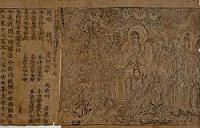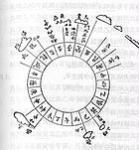The Four Great Inventions
2009-09-14 16:50 BJTThe first prescription for gunpowder appeared in 1044, much earlier than the earliest (1265) gunpowder-making instructions recorded in Europe. By the Song Dynasty (960-1126), gunpowder was in extensive use. Weapons made with it included rifles and rockets. The Song army also used a kind of flame thrower which involved packing gunpowder into bamboo tubes. The earliest picture of a European cannon shows that it bears a striking similarity to Chinese cannon of 1128.
About 1230, the Song army had cannon powerful enough to breach city walls.
A bronze Chinese cannon cast in 1332 is the oldest one in the world extant today. Many bronze and iron cannons have been unearthed in China, most of them bearing inscriptions dating them to between 1280 and 1380.
 |
| The intricate frontispiece of the Diamond Sutra from Tang Dynasty China, AD 868 (British Museum) |
On the basis of printing using carved blocks in the Tang Dynasty, Bi Sheng of the Northern Song Dynasty invented movable type printing in the 1040s, which ushered in a major revolution in the history of printing.
Bi's printing consisted of four processes: making the types, composing the text, printing and retrieving the movable types. According to Dream Stream Essays, Bi Sheng carved individual characters on squares of sticky clay, then baked them make clay type pieces. When composing a text, he put a large iron frame on a piece of iron board and arranged the words within the frame. While one plate was being printed, another plate could be composed. After printing, the movable types were taken away and stored for future use. Movable type printing has a very important position in the history of printing, for all later printing methods such as wooden type, copper type and lead type printing invariably developed on the basis of movable clay types. Bi Sheng created movable type printing more than four hundred years earlier than it was invented in Europe.
 |
| Diagram of a Ming dynasty mariner's compass |
According to ancient records, natural magnets were employed in China as direction-finding devices. This led to the first compass, called a sinan (south-pointing ladle) during the Warring States Period. In the Han Dynasty compasses consisted of a bronze on which 24 directions were carved and a rod made from a natural magnet. Such devices were in use until the eighth century.
In the Song Dynasty, Shen Kuo described the floating compass, suspended in water, a technique which minimized the effect of motion on the instrument. This enabled the compass to be used for sea navigation for the first time. The invention of the compass promoted maritime undertakings, and its use soon spread to the Arab world, and thence to Europe.
China's four great ancient inventions made tremendous contributions to the world's economy and the culture of mankind. They were also important symbols of China's role as a great world civilization.
Editor: Zheng Limin | Source: China.org.cn
 Mail
Mail Share
Share Print
Print


 Video
Video









 2009 China Central Television. All Rights Reserved
2009 China Central Television. All Rights Reserved